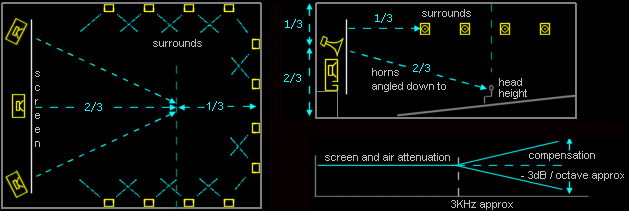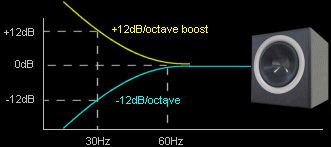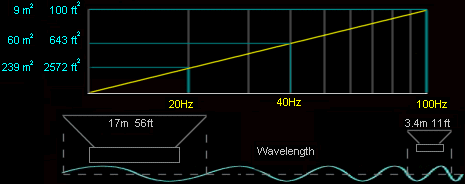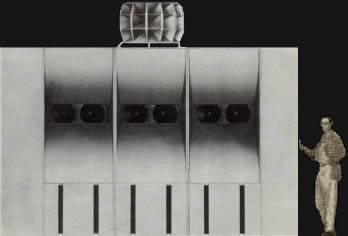Cinema sound management is divided into 2 sections. A chain refers to the sound track on the film stock, projector sound reader and Dolby decoder including other competitive decoders. B chain refers to power amplifiers, crossovers and speakers, including cinema room EQ. Traditionally the decoders and amplifiers are mounted in a 19in rack in the projector room. The long speaker cables from the projector room to the screen and surround speakers are mostly hi-current low-resistance 110V or 240V power cables which are installed by electrical contractors when the cinema is made. Commercial cinemas are not attached to any form of audiophile nonsense and therefore do not use 'magical' speaker cables.

It can be questioned why the amplifiers are not placed with the speaker system with short speaker cables, and only requiring a long signal cable from the projector room. This approach is normal with live entertainment sound systems; the answer is simply historical convention.
B Chain Speaker positions
All cinemas follow basic rules of speaker placement to provide a consistent outcome which when looked at in detail is the most pragmatic approach. The speakers behind the screen have to be angled accurately at the points shown in the below pic (to begin with). Then re-adjusted by ear to achieve a stereo image that maintains maximum consistency throughout the room. This may require a larger toe in from the left right speakers to minimise reflections from the adjacent side walls. Also an increased toe sometimes provides a better stereo image for sound buffs who prefer to sit at approx 1/3 distance from the screen. Those who wish to sit at the rear of a cinema; stereo image will have no value.

Different cinema screens will attenuate high frequencies to varying degrees, and it is essential to place the high frequency horn as close as possible to the screen. Air also absorbs high frequencies over long distances which has to be adjusted for large cinemas. A variable 3dB per octave lift above 3kHz can easily compensate for all high frequency losses.

The front speaker cabinets should also be placed in a large baffle behind the screen as shown with the JBL speaker system in the above pic. The baffle provides forward propagation for the lower frequencies. The baffle also stops sound from reverberating against the wall behind the screen. The difference between having a screen baffle is very noticeable in improving the sound system performance. However very few cinemas are prepared to incur this extra expense. Information on the left-center-right screen speakers are covered in more detail in the chapter of 'Large Systems'.
Surround speakers
Live musical concerts including opera do not have surround sound. Sounds from other directions cause audience distraction. Reverberation and echoes reduce intelligibility, therefore favoured seats are closer to the stage. However the movie experience is enhanced by surround sound to create spatial environmental effects; providing it does not distract or conflict with the front system.
Home cinema marketing states that the surrounds should be the same speakers as the front. But this is never the case in commercial cinemas. A stated requirement for commercial cinemas is that the total sound energy from all the surrounds must be capable of matching one of the front screen speaker systems. However sound energy from the surrounds is almost never required to equal the loudness capacity of a front system. This is possibly stated to insure that the surrounds are always capable of delivering what they should.

Surround speakers normally begin at approx 1/3 of cinema distance from the screen. The basic mounting positions above are a guide and the final positions should be adjusted by ear. The height and downward angle of the surround speakers is aimed at achieving the minimum loudness difference from wall to center seats (approx -3dB). Also the total surround level is calibrated with pink noise to be approx -3dB below the level of the main screen system.
Surround delay time A mandatory 20milli second delay is applied to maintain hearing attention to the front speakers. Delay time is then extended to the distance time of the cinema length in 1 milli-second steps (1 milli-sec = 340mm 1.1ft). A cinema length of 34m (110ft) will require an extra 100 milli (1/10) second delay. The Dolby processor automates this procedure. Be sure to follow the processor instructions carefully and double check the cinema measurements. The final adjustment is calibrated by ear and any error must be biased toward reducing surround level, not toward increasing surround level.
The surround speakers should not be heard directly as point sources, as this causes distraction from the screen system. Surrounds are meant to disperse the sound in a diffused manner, similar to how we hear sound in the far field natural environment. But surround speakers are constrained by walls, that cause the sound to be heard from the nearest speaker only. This problem puts impossible constraints on the recording engineer.

Line source surround The perfect surround system would consist of large numbers of 8in speakers on each wall as in the above pic. A line source disperses at -3dB / 2 distance, not -6dB as from point sources. Also a horizontal line source behaves as a natural diffused sound field, similar to how sound disperses in nature from wind, rain, motorways, urban environments and crowds. The line length can be sub-sectioned into groups of 4 to 6 speakers. Each speaker group can be independently powered and delay sequenced to obtain moving spatial sound effects similar to chaser lights.
Using large numbers of speakers to achieve a line source and sequenced delays would not have been economically viable in the early days of cinema. A high quality 8in speaker in the west may be $50 - $100 , but these speakers are often shipped from China in packs of 200, for less than $10ea. The digital management for sequenced delay is simply achieved. All that is required is will, imagination and a passion for cinematic entertainment.
 There are never ending debates about which surround speakers are best. In commercial cinemas it is inadvisable to use speakers with 70V line transformers, as applied in the ceilings of shopping centres. These speakers are often of the lowest quality and can easily be destroyed with a few Watts. Also line transformers restrict bandwidth and can saturate with dynamic range, especially at low frequencies. When a line transformer saturates it behaves similar to a short circuit and creates extreme distortion.
There are never ending debates about which surround speakers are best. In commercial cinemas it is inadvisable to use speakers with 70V line transformers, as applied in the ceilings of shopping centres. These speakers are often of the lowest quality and can easily be destroyed with a few Watts. Also line transformers restrict bandwidth and can saturate with dynamic range, especially at low frequencies. When a line transformer saturates it behaves similar to a short circuit and creates extreme distortion.
If possible wire each surround speaker independently to the projector room, and then connect the speakers from each row in series parallel arrangement at the amplifier rack. This procedure uses a lot of excess cable, however this enables simpler maintenance in the future, to isolate and replace a faulty speaker.

Parallel vs Series-parallel Connecting speakers in series parallel, may be essential where only one amplifier is available. However, connecting speakers in series causes the distortion of the speakers to be reflected into each other. Also the impedance of a speaker at resonance and at hi-frequencies can be approx x4 greater than the rated impedance. This can cause chaotic behaviour including restricting the power and therefore the loudness the speakers can be heard at. The majority of amplifiers are designed for approx 4R output impedance which only allows for 2 8R speakers to be connected in parallel. Therefore a stereo amp will enable 4 8R speakers to be wired to it. Parallel wiring of speakers speakers requires extra amplifiers and higher cost and is worth the effort.
Speaker phase Understandably the surround speakers must be in phase with each other. But because surrounds are collectively delayed in time, it is not possible to apply speaker phase that is matched to the front system. However it is correct practice to have the speaker phase + in reference to the amplifiers.
Bass - Sub-bass
The ability to provide deep bass had been understood since the 1930s. Some of the large wide screen cinema sound systems in the 1950s could easily manage 40Hz. Also during the 1950s some DIY (do to yourself) hi-fi enthusiasts made large brick speaker enclosures with 15in speakers in the corners of their living rooms easily achieving 20Hz. The only limitation was the needle jumping off vinyl records. Many Rock concerts in the 1960s used large folded horn bass bins.
The first mass audience experience in cinema of powerful separate sub-bass was created for the "Earthquake" movie in 1974 using very large Cerwin Vegar bass bins in a system described as 'Sensurround'.
Sound quality especially sub-bass was never seen as being important for 35mm main-stream cinema. The majority (but not all) cinema sound systems were and still are made as cheap as possible; 2 x 15in with a horn, as in the below pic. Bass frequencies of 40 - 60Hz are approx -6 to -12dB below voice range. Because cinemas are quiet environments the bass can still be heard at this lower level. This is the reason the problem had not been previously addressed.

By the late 80s Dolby SR became available providing sub-bass extention which was promoted vigorously. When digital arrived the sub-bass was available as a separate LFE Low frequency Effects channel. Dolby's success was in understanding that the majority of cinema management would spend as little as possible to improve sound. The separate sub-bass extention is the simplest low cost solution, requiring only 1 extra amplifier with a single 18in bass speaker (approx $2,000) to be added to an existing cinema system.
Our ears are in-sensitive to bass frequencies, and combined with the 18in speaker being less efficient than the speakers in the main system which requires the 18in to be equalised and driven with greater power, to be heard at the same level as the voice frequencies. 1,000 Watt amplifiers are commonly used. This is the primary reason sub-bass is not included in the main front channels and has to be separate.
An average 18in bass speaker cone has a fundamental resonance (Fs) of approx 35Hz in free air. When the speaker is put in a 10 cubic ft (260 Litre) box the speaker resonance is made higher; approx 50 - 60Hz. To achieve deep bass a resonant port is put in the box and tuned to approx 30Hz, not 20Hz as often believed.
The port (Hemoltz resonator) will generate a resonant note only at the frequency it is tuned to in reverse phase. The port resonance is also activated by any movement of the cone at other frequencies at a lower level. Many musicians who play electric bass guitar, including a % of discerning audiophiles, do not use bass boxes with ports. However ported boxes have a fanatical following singing their virtues.

Port problems For a port to be maximally effective it should be similar in diameter to the speaker and very long. But a large port similar to the size of the speaker is not practical as it would have to extend outside the box. So for the port to fit inside the box it is reduced to a smaller size. These smaller ports are less efficient and generate greater air velocity, which can create whistling sounds. Also any frequencies from the amplifier that are below the port resonance, cause decoupling of air loading to the cone, generating excessive cone movement (exertion) that can easily destroy the speaker. Cinema projectionists often describe how common this problem is.
To deal with this problem many speaker manufacturers make the cone suspension tight, which raises the Fs, compromising bass performance for reliability and higher power rating. Also a filter is sometimes used to stop bass frequencies below port resonance getting to the speaker. All of this amounts to being a bag of worms that has to be managed. But ported boxes are the only way to achieve effective 'cheap' deep-bass. This is not right or wrong but simply physics.
Sealed box In a sealed box, a speaker cone must move 4 times the distance for each octave decrease to maintain the same acoustic output, providing the bass wavelength does not exceed x 10 speaker diameter. This is the reason a 4in speaker cannot deliver sub-bass at a reasonable level for home cinema regardless of how far the cone can be made to move. This can be simply demonstrated by waving ones' finger in the air, compared to a large sheet of paper.
Many active sub-woofers for home cinema and vehicles use 10in or 12in speakers in small sealed boxes of approx 1 - 2 cubic ft (30 - 60 litres). The speaker resonance can be as high as 60 - 100Hz. Below system resonance the cone cannot increase excursion at 4 times the distance for each octave decrease, which is the minimum required to maintain constant acoustic output. Below system resonance the cone excursion is kept constant, by air compression in the small box. Bass efficiency rolls off at -12dB/octave below resonance. (-12db = 1/16)

Sub-woofer EQ Many sub-bass amplifiers have special equalization (EQ) to boost amplifier power, compensating for the decrease in efficiency below resonance. If the speaker-box system resonance is 60Hz, and the system is required to be flat down to 30Hz, then the amplifier will have to deliver (+12dB) 16 times more power at 30Hz, to force the cone to move 4 times the distance. These speakers have heavy cones and are inefficient. Amplifier power for domestic application can be approx 300 Watts.
To understand the management of bass and sub-bass frequencies requires relating to the frequencies as their wavelengths. The velocity of sound is approx 344m (1125ft) per second.
- 100Hz wavelength = 3.4m (11.25ft)
- 42Hz wavelength = 8m (26ft) lowest note on double bass
- 20Hz wavelength = 17.2m (56.4ft) lowest sub-bass effect

The imagined ideal is for the speaker diameter to be equal to the longest bass wavelength. But this would require the sub-woofer to be the approx size of the cinema screen.
Perfect cinema sub-bass. For the sub-bass to maintain the same directivity and efficiency as the 2 x 15in speakers in front main speaker boxes, the total area of the sub-bass speakers should be approx x4 the area of all the 15in speakers in the left-center-right boxes. This requires 6 x 30in speakers. Because 30in speakers are not normally available, 6 x 18in speakers is practical.

In sealed boxes the 18in speakers will have to have a low Fs fundemental resonance (very loose suspension) less than 25Hz. The boxes will need to be very large approx 20 cubic ft (600 litres). The speakers will still require extension EQ to force them to reach down to 20Hz at equal power. The bass boxes will deliver more propagational energy if they are stacked together in one place. However to minimise excessive cancellation from standing waves throughout the cinema, it is best to separate the bass boxes as in the above pic.
High quality 18in speakers are expensive, and most are made with high Fs (stiff surrounds) to keep the voice coil centred, which unfortunately defeats its ability to produce deep bass in a sealed box. Most 18in speakers are designed to be used in ported boxes only.

A cost effective solution that performs as well (if not better) is 24 x 15in hi-fi speakers (2in voice coils approx $100ea). These speakers are readily available with soft surrounds that have a low Fs approx 25Hz. The cost is low because they are made in large quantities. The 15in speakers have to be in compound pairs, each pair acts as a single speaker. This arrangement does not look attractive, however it gives excellent linearity, low distortion, at very low frequencies. Each sealed box will still have to be approx 20 cubic ft (600 litres) and may require a small amount of extended bass EQ to achieve 20Hz at equal power.
Sub-woofer Phase It is not stated that sub-woofer phase is required to be matched to the front left-center-right speakers. This is because it is regarded as a separate channel with different information. But this not a correct assumption because at times the same bass information can be applied to the sub-bass channel and front speakers. This should be checked independently with a signal generator to ensure both sub-woofer and front speakers are in phase at the crossover frequency. Do not attempt phase correction with pink noise measurement using microphones in the far field as this result can be randomly influenced by cancellations from standing waves.
Time alignment As an imaginary concept if the whole frequency response (from each speaker) radiated from a single point then all the frequencies would be in time with each other. With large cinema sound systems the low and hi-frequency drivers are separated by small physical distances. With the old large Altec A4 system below pic, the 15in speakers and horn driver were mechanically in line on axis, so there is zero time difference to the audience. But the vertical height difference between the drivers is approx 2m (6ft) and at 344m /second is a 6 milli-second time difference which can be considered audible for someone sitting underneath the speaker system in the front row. This is similar to being at the front or on stage when listening to a live band.

Time differences of less that 10 milli-seconds of sharp transient clicks can not be heard as separate, but as a single fattened partially muffled click. A common practice in pop recording is to add multiple short delays of less than 15 milli seconds to voices and instruments to give them a fatter sound. However time differences of transient clicks beginning from 11 milli-seconds gradually start to be heard and become clearly separate when approaching 30 milli-seconds 10m (30ft)
The problem of separate double clicks was first noticed with very large speaker systems in the 1930s when Fred Astir and Ginger Rogers tap danced. At first this was confusing because the distances between the low and hi-frequency drivers were not great enough for the distinct double clicks to be as extreme as they were.
The early multi-cell horns were designed to have a wide dispersion to provide sound to the upper and side balconies. But these wider dispersion horns caused slap echoes from the ceiling and side walls to be greatly increased. Modern cinema horns have a narrow controlled directivity compared to the earlier multi-cell wide directivity horns.
Time alignment correction including phase correction should be considered as good housekeeping, regardless if it is audible or not.
Time alignment myths Audiophiles with golden ears claim that time alignment correction for very small differences between woofer and tweeter of approx 100mm (4in) have to be time align corrected. They believe that this small correction transforms the entire performance of a sound system, similar to using magical speaker cables. Time alignment differences of less than 1 milli-second are acoustically transparent as double blind ABX tests have proved. Many audiophiles will not buy any product including power cables if it does not have the words 'Time Aligned' printed on the packaging. Unfortunately there are many so called recording engineers that have the same mystical beliefs.


